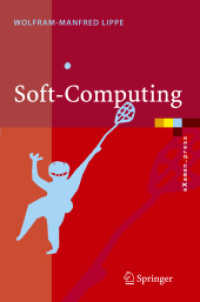- ホーム
- > 洋書
- > 英文書
- > Nature / Ecology
Full Description
The earthworm has been known since ancient times for its valuable services to soil fertility management and litter nutrient cycling. The Greek philosopher Aristotle named earthworm "the guts of the soil" because of its direct role in soil formation through gut fragmentation of large soil particles, forming fine soil aggregates rich in organic matter. The famous natural scientist Charles Darwin also described the importance of earthworms in the natural world and he wrote the document entitled "The Formation of Vegetable Mould Through the Action of Worms with Observation on Their Habits" in 1881, observing that "worms have played a more important part in the history of the world than most persons would at first suppose". During the last 30-40 years, earthworms have been studied intensively in the various disciplines of animal ecology, paedology, waste recycling, agriculture science, soil biology and chemistry, ecotoxicology, and pharmaceutical sciences. Because of their importance in soil and below-ground ecology, earthworms have been designated as "ecosystem engineers". Soil fertility maintenance, soil litter decomposition, soil microbial communities and other detritus community structures and their function are directly or indirectly affected by earthworms' presence in soils. Apart from that, earthworms have appeared as a promising tool to recycle nutrients from various kinds of organic waste substances and stabilization of industrial sledges. Vermicomposting could be a valuable and low-cost technique for farmers for onsite waste management and nutrient-rich manure production. Scientists are always looking for new species for solid waste management. Thus, scientists around the world are working on earthworm biodiversity assessment and evaluation of their ecosystem services and value addition in other environmental management sectors. Efforts have been made in this edited volume to compile recent advancements in earthworm biology and their promising services in different fields of environmental management and resource conservations. This book contains three sub-sections: earthworm ecology, vermicomposting, and earthworm ecotoxicology. A total of 17 chapters are included in this edited volume. In the first section two chapters cover phylogeny and distribution of earthworm, and distribution of earthworm in Canadian ecozones; in the second section a total of seven chapters are included describing the role of vermitechnology in bioremediation of agriculture waste, pharmaceutical waste substances, industrial sludge stabilisations, and soil nutrient supply; and the third section includes eight chapters describing the effect of various hazardous substances like pesticides, microplastics, heavy metals, and neonicotinoids on earthworm growth, survival, reproduction and toxicity. In the end, we acknowledge the people and family members who are directly or indirectly associated with the compilation of this book. Without their moral and technical support, this book would not see the light of day.
Contents
Preface; Phylogenetic and Genetic Discernment with Respect to Multi-Gene Catenation in Earthworms (Clitella: Oligochaeta): A Global Conspectus; Earthworms (Oligochaeta: Lumbricidae, Megascolecidae and Sparganophilidae) in the Canadian Ecozones; Vermicomposting: A Promising Tool for Sustainable Agriculture; Vermibiotechnology: A Promising Tool for Waste Management and Organic Farming; Compost and Vermicompost Production from Plantain Waste A Quality Assessment; Vermistabilization of Industrial Sludge; Bioremediation of Wastewater Sludge from Pharmaceutical Industries through Vermistabilization; Earthworms as Ecological Engineers and its Role in Bioconversion of Organic Waste through Vermicomposting; Effect of Vermicompost, Farm Yard Manure and Biofertilizers on Soil Health and Plant Nutrition; Ecosystem Engineering by Earthworms; Ecotoxicological Assessment of Pesticides in Earthworms; Source, Extraction and Identification of Microplastics and their Effects on Earthworms; Microplastics and Earthworms; The Potential Risk of Soil Microplastic Contamination on Earthworms; Neonicotinoids: Effect on Survival, Growth, Reproduction and Genotoxicity in Earthworms; Earthworm Ecotoxicology: Role of Heavy Metals and Nanoparticles; Effect of Lead-Contaminated Soil on Survival, Growth, and Reproduction in Earthworms (Eisenia fetida); Index.
-

- 電子書籍
- 紫藤るい NEXT推しガール! 3 ヤ…
-

- 電子書籍
- 奇跡の出会い 王子に魅せられて I ハ…






